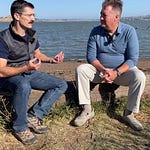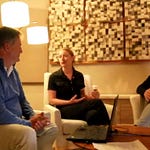Last month, I went to Stanford and did four years of college in four hours. Jennifer Dionne has been on the podcast before. After showing me some amazing technology in her lab (nanoparticles - I’ll share some clips on LinkedIn later) we wandered over to the Polynesian Garden to talk about her class, the Science of the Impossible. I avoided the waitlist and got the Cliff Notes version, which was enough to fill my brain for the day.
Our conversation started with her path to becoming a scientist (inspired by The X-Files) and ended with discussion of deploying remote sensors in the environment to understand shark populations around Palau based on detecting their DNA in ocean water.
In between, we talked about the role media plays in sparking scientific interest, how she encourages students to think about big, difficult problems and the value of “curiosity-driven” research that can lead to unexpected discoveries, such as Faraday’s work with semiconductors and the accidental origins of chemotherapy. Oh yeah, teleportation was in there as well. Watch the video.
In the class, they discuss scientific breakthroughs that were once thought impossible but also how to approach scientific problems that seem impossible now. What are the mindsets and the approaches that lead to progress on significant challenges?
Jen suggests thinking of a conversation with future grandchildren. What do you want to say you contributed to the world they live in?
So here I’ll follow her model and maybe take a step forward. We start by thinking of the problem we want to solve and then the aspects of that problem that make it difficult to address now. These are not all technical challenges. It often comes down to policy and infrastructure.
Are you subscribed yet? If not, let’s fix that.
I’d like to help build an infrastructure of public understanding for tackling long-term threats like climate change. This has been on my mind, especially since reading Fire Weather: A True Story from a Hotter World.
As early as the 1970s scientists understood the challenge of global warming caused by CO2 emissions. It was neither polarizing nor controversial. But then, as now the perception was that there are more immediate threats - economic threats like inflation or unemployment, or physical threats of disease or geo-political conflicts that demand immediate attention.
Humans are very good at identifying near-term threats and dealing with them as best we can. Long-term opportunities provide plenty of motivation (usually money) and don’t need much help. Long-term threats, not so much. Can we reframe those threats to become opportunities in a tangible and meaningful way?
These opportunities are often called moonshots now, not just because of their lofty goals, but because of the inspiration they provide and the possibility of developing important and useful technologies on the way. One advantage for the Apollo program, besides national security considerations, was that every human being that ever lived has looked at the moon and wondered what it was like up there. The problem was relateable and easily visualized.
Reversing climate change is certainly a lofty goal. But success is not easily visualized. Rather than spinning off multiple technologies that can serve other purposes, it will instead require the development of many new independent solutions that each contribute to the goal. Based on the work that Jen’s lab is doing on carbon capture and environmental sensing as well as the work of others, I have no doubt the technical challenges can be solved. That leaves policy and infrastructure.
Solving climate change requires not just agreement within, but also between nations. Public understanding and trust in science comes back around to the media and storytelling.
The stories we tell as science marketers and communicators, like Fire Weather, are an essential component of driving the policies that will enable the infrastructure required for success. We must continue to highlight the scientific advancements and give more visibility to the people that are doing that work. Let’s inspire the next generation and restore trust in science.
In case you didn’t catch this on LinkedIn, here is some bonus content where Jen is talking about some mind-blowing uses for nanoparticles.
Your deepest insights are your best branding. I’d love to help you share them. Chat with me about custom content for your life science brand. Or visit my website.
If you appreciate this content, you likely know someone else who will appreciate it too. Please share it with them.












